When planning a traditional winter vacation, we were choosing between South Africa, Mexico, and the Seychelles Islands.
We ruled out South Africa just an hour before buying tickets when they re-imposed COVID restrictions, and we decided not to take the risk. Mexico was postponed for another time, combined with the United States.
The Seychelles initially raised some doubts for us because we had read quite a bit of negativity online. However, most of the negative reviews mainly focused on expensive beer and poor hotels. It was believed that the hotel prices did not match the quality of service. Almost all such reviews were from those who bought package tours. This is another reason why traveling independently is better.
However, most critics agreed that the natural beauty was worth experiencing. Furthermore, independent travelers tended to enjoy the islands more than package tourists. We decided that it’s better to see it for ourselves rather than rely on a hundred readings or YouTube videos, so we bought tickets on Qatar Airways.
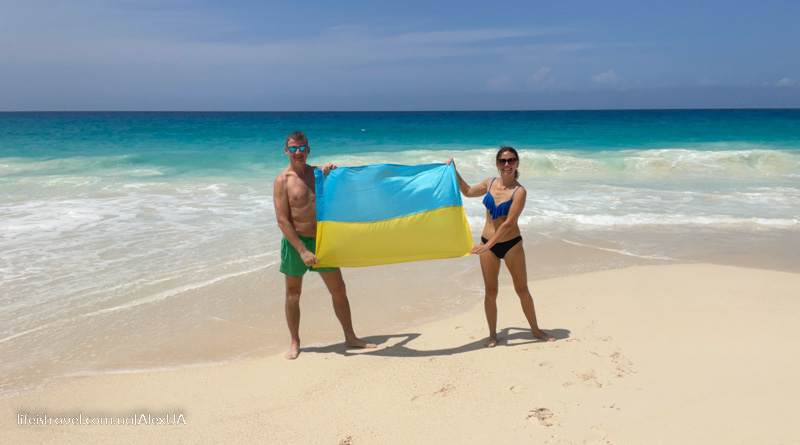
Location, Geography, and Nature
This tropical paradise is located just south of the equator. The Seychelles archipelago consists of 115 islands, with only 33 of them being inhabited. The most popular ones include Mahé, Praslin, La Digue, Silhouette, and Curieuse.
The climate is stable and tropical, with temperatures ranging from 26 to 30 degrees Celsius year-round. There is a wet season, which coincides with our winter. In fact, rain can fall at any time and during any season. The worse the island, the more likely it is to rain.
This is why rain and storms are more common on the main island of Mahé and less frequent on islands like La Digue and Silhouette, as they are less mountainous.
We visited in winter, for two weeks in February. There were 12 sunny days with beautiful clouds, 2 cloudy days, and one day of real tropical rain. Weather-wise, it was wonderful and pleasant.
Another natural feature is the large granite boulders on almost all beaches, turning cozy bays into incredibly photogenic ones.
Large Seychellois tortoises can be found everywhere, often wandering on roads or along the beaches.
The Coco de Mer palm tree, which resembles a pair of buttocks in shape, is also widespread. These palms grow everywhere, and on Praslin, there is a whole natural park called Vallée de Mai dedicated to them.
This sums up the most important natural features of the Seychelles.
Language
The Seychelles were discovered by Vasco da Gama in 1502. Then pirates ruled there for nearly two centuries. After them came the French, who brought slaves from Madagascar and the East African coast. By the way, the French named the islands after their finance minister, de Séchelles.
After the French, the Seychelles became a British colony in 1814.
Now it is an independent state with a Creole population. The official languages are three: French, English, and Seychellois Creole French. Everyone on the islands speaks these languages.
There are no language barriers for travelers who know basic English or French.
The people are very friendly and not greedy. When dealing with foreigners, they may have a money counter in the back of their minds, but it’s not as obvious as in other African or Asian countries. They will show you the way, help with car rentals, tell you about beautiful secret beaches, offer fresh fish, and even sell you beer before 11 in the morning.
Today, there are three official languages: Seychellois Creole, French, and English. Most Seychellois speak English, and nearly everyone speaks French. They communicate with each other in Creole and occasionally in French. Even if you don’t speak any of these languages, locals are generally friendly and patient, and they’ll try to understand you, even through gestures.

Entry Rules for the Seychelles
For Ukrainians, there are no privileges due to the war. The country is small and simply lacks additional resources for refugees.
To enter the Seychelles, you need:
- A valid biometric passport.
- A visa issued upon arrival for 30 days, which can be extended for an additional 30 days.
- Hotel reservations, Booking is sufficient.
Getting to the Seychelles Islands and Renting a Car
The logistics are very straightforward.
We flew with Qatar Airways. The ticket cost $820. It’s a short and convenient layover in Doha.
Doha Airport is convenient in terms of internal logistics and options for relaxation between flights. There is free internet and plenty of cafes and restaurants. No complaints. The same can be said for the Dubai terminal, through which we also flew to Asia several times.
We bought our tickets through Aviasales, an international flight aggregator.
We arrived on the island of Mahé, the main island of the Seychelles archipelago. It has a small and cozy island airport with a modest terminal that had difficulty accommodating two incoming flights – ours and Emirates, which landed a little earlier.
Visa formalities, a stamp from the most famous coconut in the world in your passport, and a mandatory duty-free shopping before departure. A few liters of British gin and dry martini fit perfectly into such a climate. Everything is available locally, but it’s 30-40% more expensive.
The next step is renting a car. We didn’t consider other transportation options, although there are buses on the island. You can get almost anywhere, but it takes more time, and you often have to walk uphill to the desired beach.
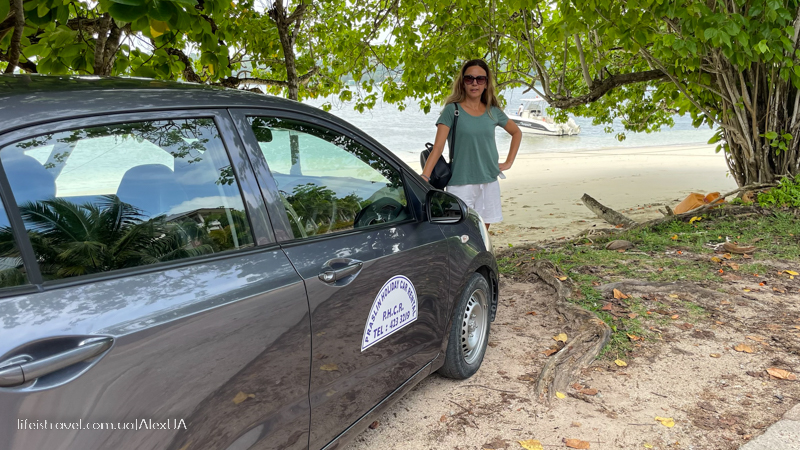
A car is a must if you want more flexibility
On Mahé, we booked a car a week before our departure through Rentalcars. The price was $60 per day for a small Hyundai I20.
On Praslin, we looked for a car on-site through the villa owner, and it also cost us $50. We were lucky; there were no cars available, but the villa owner found one for us through her connections. In the end, we took the last car, as she said. She didn’t take any money for her part in our fortune.
In conclusion, you can book a car in advance and sleep peacefully, or you can save some money but with no guarantee that cars will be available.
Car rental in the Seychelles is not as straightforward as in Europe. The main difference is that cars are not always available. I’ve already written in detail about car rental in the Seychelles, hoping it’s useful.
Choosing an Island in Seychelles: Our Seychelles Island-Hopping Itinerary
For those visiting Seychelles for the first time, it’s common to choose a combination of two or three main islands. These typically include Mahe Island, the main island, Praslin Island, and La Digue Island, which are close to each other and equidistant from Mahe. Ferries operate between these islands.
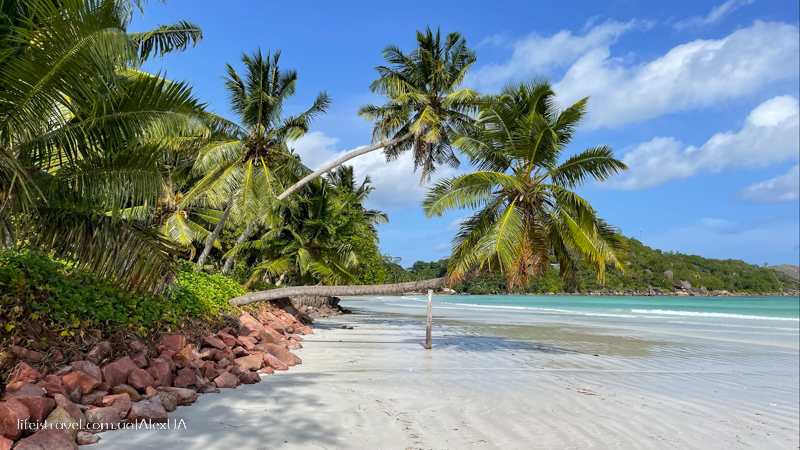
From these islands, you can also take a day trip to Silhouette and Curieuse Islands.
Our travel itinerary can be considered classic or standard: Mahe – La Digue – Praslin – Mahe. This is an optimal program for first-time visitors. You can switch La Digue and Praslin if you like; it won’t make much of a difference.
We adjusted our schedule based on our logistics and flight. Although you could leave La Digue as a dessert, we didn’t need to do that.
We allocated our time on each island as follows:
- 6 days on Mahe
- 4 days on La Digue
- 5 days on Praslin
- Almost a full day back on Mahe before flying home.
In total, it was a little over two weeks, not counting travel time.
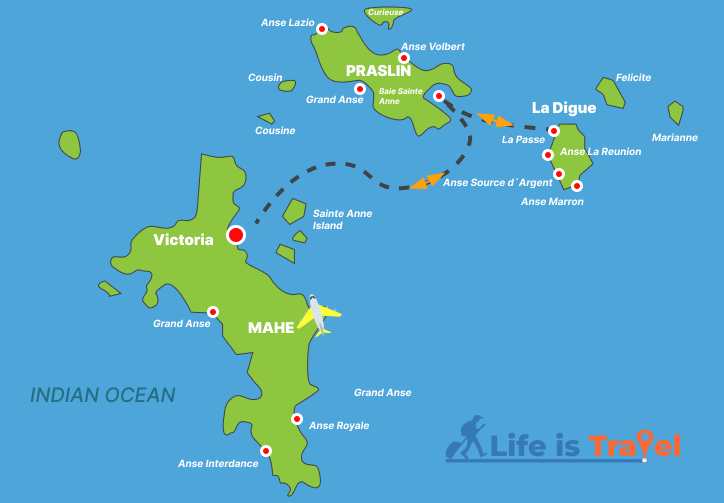
About Each Island
We arrived on Mahe Island, which is the largest and the main island in Seychelles. Victoria, the capital city, international airport, and ferry port are located here. We spent a week on Mahe, exploring all the best beaches, landmarks, and beautiful spots. We also went into the mountains and enjoyed the island’s views from high above.
Getting Around the Islands
On Mahe and Praslin, as mentioned earlier, we rented cars through the Rentalcars website a couple of weeks before leaving from Kyiv.
There are buses on Mahe and Praslin, which are inexpensive, but you may have to wait for them for a while. If you have time, patience, and are willing to do a lot of walking on hilly terrain, you can skip renting a car and take the bus, saving a few hundred dollars.
La Digue, on the other hand, doesn’t have cars except for special vehicles, so we rented bicycles. We got them from our guesthouse, where the cost was $10 per day. Without bicycles, it would have been challenging to explore the island.
Inter-Island Travel
Most of the islands in Seychelles are connected by ferry and air travel. We used ferries and bought tickets a week before departure online through the Cat Cocos website. We printed the tickets and showed them at the port reception. We found Cat Cocos to be punctual, fast, and comfortable, even when the ocean had some minor waves. We had no issues; everything went smoothly.
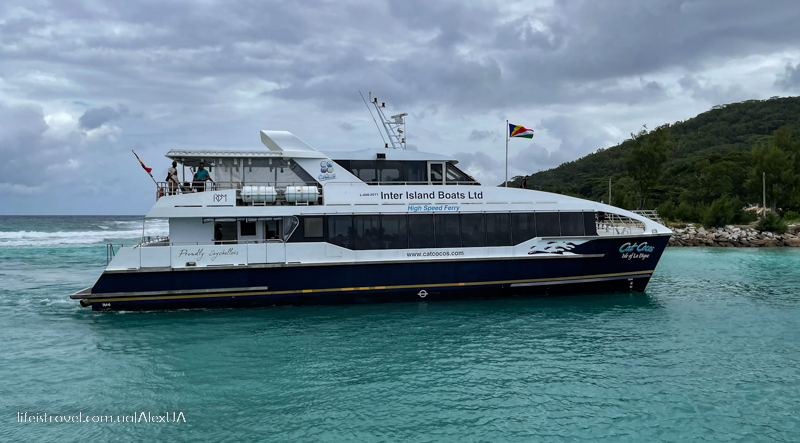
The ferry terminal is located in Victoria, the capital, relatively close to the international airport. You can’t walk there, so you’ll need to take a taxi and say “Ferry Cat Cocos.” It’s a 10-15 minute ride, depending on traffic. The taxi from the airport costs 20-30 euros, and the final price depends on your bargaining skills. Taxi drivers are typically open to negotiation.
If you have extra money to spare, you can also use domestic flights between islands. Air Seychelles operates flights between the islands, with prices ranging from $400 to $600 for a one-way trip per person. The local terminal is next to the international one.
Best Time to Visit Seychelles – Weather
Seychelles is a year-round destination. The rainy season typically occurs from November to February. We visited in February, and there were only two days of rain, with one heavy tropical downpour a couple of days before we left.
I recommend visiting Seychelles in late autumn, winter, or early spring when it’s cold and wet in our regions. However, there are also enthusiasts who enjoy summer vacations in Seychelles. I have no objections – why not?
The high season for Seychelles is considered to be from May to the end of October, as well as January. During this time, prices are slightly higher, and there are more tourists. We visited during the so-called low season when rain was expected but experienced only a few brief showers in 16 days. Remember, we were there in February. The ocean was a bit rough, so swimming wasn’t possible on all beaches due to the waves.

In February, the weather was mostly sunny with beautiful clouds. There were only two or three days with overcast skies, and they occurred just before our departure, along with brief showers.
Rain in Seychelles means short and scattered showers. The terrain is hilly, so rain might fall on one side of the island while it’s sunny and dry on the other. On the flat La Digue, showers didn’t last long because there was nothing for the clouds to linger on. Praslin and Mahe are hilly, especially Mahe, where it rained on the day we left.
In conclusion, you can visit Seychelles at any time of the year. Less waves are expected in April and May, making swimming more enjoyable. The occasional rain shouldn’t cause significant problems. The temperature is around 30°C during the day and 26-28°C at night year-round. The ocean temperature stays between 25-27°C all year, and there’s no extreme heat.
Accommodation in Seychelles
There are various options for accommodation in Seychelles, catering to different preferences and budgets. Here’s an overview of the types of accommodations available:
- Luxury Hotels: Seychelles offers luxury hotels that can cost anywhere from 2,000 to 10,000 dollars per night. These hotels provide top-notch amenities and services.
- Mid-Range Hotels and Villas: Most tourists opt for mid-range options, which include modest hotels and villas ranging from 70 to 140 dollars per night. These provide a comfortable stay with a more reasonable price tag.
- Budget Guesthouses: If you’re on a tight budget, you can find guesthouses with rooms priced from 60 to 80 dollars per night for two people. These are often more affordable than hotels and offer a cozy stay.
During our trip, we stayed in a villa with a separate entrance, kitchen, garden, and ocean view on both Mahé and Praslin. The prices ranged from 80 to 100 dollars per night. On La Digue, we chose a budget-friendly guesthouse for 70 dollars per night, which was our most economical accommodation during the trip.
When it comes to accommodations, we prefer private options like apartments or villas over hotels. Keep in mind that many negative reviews of Seychelles as a destination are often related to hotel experiences. The choice of accommodation depends on your travel style and preferences.
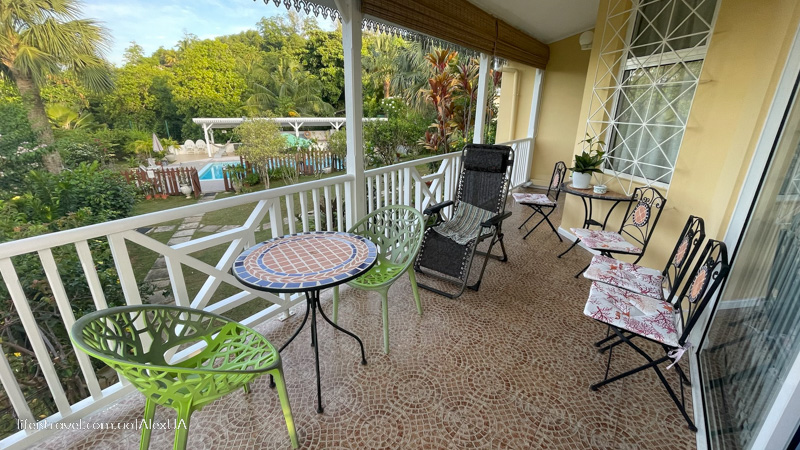
As for prices in Seychelles, it’s worth noting that opinions vary. Some travelers, especially those who explore independently and don’t stay in expensive hotels, consider Seychelles to be a budget-friendly destination. They compare it to the costs in Croatia, Italy, or even Provence.
On the other hand, some tourists who opt for high-end hotels, don’t rent cars, and rely on taxis or dine at hotel restaurants might find Seychelles to be more expensive. In reality, accommodation costs are similar to those in Cyprus or Croatia, ranging from 70 to 100 dollars per night for ocean-view apartments with balconies and parking.
Restaurant prices also vary, with expensive options costing around 50 to 100 dollars per person, while more reasonable options can be found. For instance, we had a meal for two with octopus and wine for 60 dollars on La Digue. Taking away food from local shops is also a budget-friendly choice, with meals costing around 10 dollars for two.
Car rental is somewhat more expensive in Seychelles, around 50-60 dollars per day, compared to 25-30 dollars in Europe. Ferry tickets range from 15 to 60 dollars depending on the distance, slightly more expensive than ferries in Croatia or Greece. Flight prices are on par with flights to South America or the USA.
We didn’t find Seychelles to be overly expensive during our trip. Of course, this perception can change if you choose expensive hotels, use helicopters or inter-island flights, rely on taxis instead of renting a car, and dine exclusively in tourist restaurants.
Local beer is relatively costly at 2-3 dollars for a small bottle (0.33 liters), while imported beer can be around 3-4 dollars.
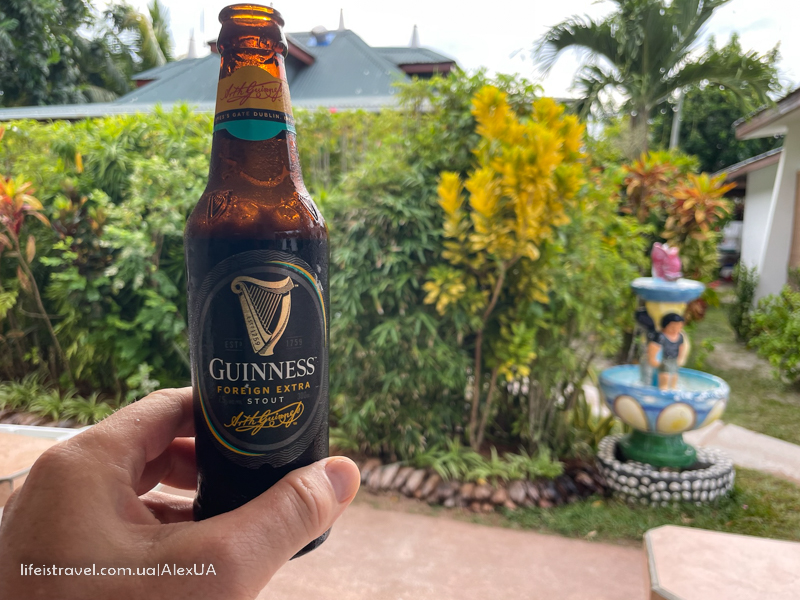
In summary, Seychelles is affordable for travelers with varying budgets, and it’s possible to enjoy the beauty of the islands without breaking the bank. Bring US dollars or euros for currency exchange, but it’s more convenient to use Seychellois rupees for day-to-day expenses. ATMs are readily available, but they may charge up to 4% in fees and offer less favorable exchange rates.
Seychelles Landmarks and Best Beaches
Seychelles is a place of both complexity and simplicity. Each island boasts at least a dozen captivating beaches. Here, I’ll highlight the top three that you must visit.
Mahe Island
The best beaches on Mahe are located in the southern part of the island, if you’re looking at it on a map. There’s no doubt about that. These beaches are named after the bays where they’re situated, with a touch of French pronunciation. Here are the original names, presented in the order I liked them:
- Anse Intendance
- Anse Soleil
- Anse Royale
The most famous Seychellois beach, Beau Vallon, turned out to be a typical tourist spot that doesn’t quite live up to the Seychelles paradise image. After reading reviews, it’s clear that many never ventured beyond this beach, except for a few tours.
Praslin Island
There are also several excellent beaches on Praslin that I can recommend, and I’m ready to give you a detailed overview of the best ones. A good beach is all about photogenic beauty, easy access to the water, and the absence of seaweed.
Best Praslin Beaches
- Anse Lazio
- Anse Boudin
- Anse Volbert
La Digue Island
The very same island with the most photogenic and best beach in the world, the one that lures tourists in. Despite its modest size, La Digue offers plenty to do. Be sure to read a full guide to the top 18 landmarks and activities on La Digue to make the most of your visit.
Best La Digue Beaches:
- Anse Source d’Argent – yes, the most famous and heavily advertised one, but it has an entrance fee.
- Anse Patates Beach – small and cozy, with beautiful boulders.
- Anse Cocos – remote and less crowded.
For now, this is a brief overview, but there will be a separate review for each island and all the best beaches.
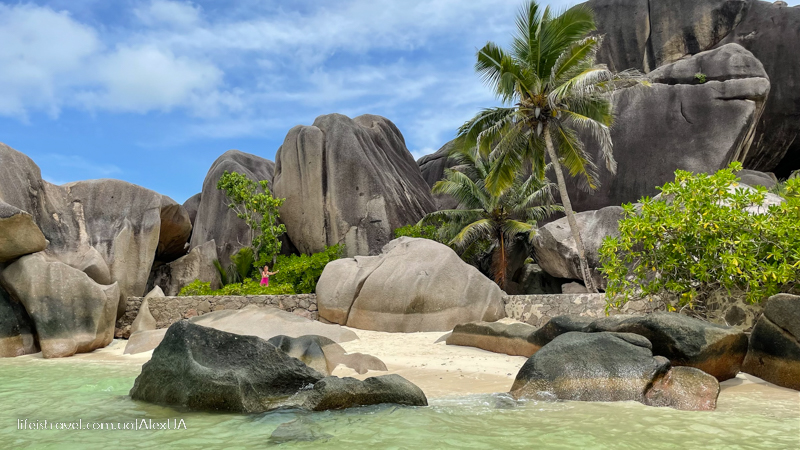
What to See Besides Beaches in Seychelles
Victoria, the capital on Mahe Island, is the historical center with a marina, scenic mountain viewpoints, and surrounded by mountains. After a week on La Digue or Praslin, Victoria might feel like a big city.
Vallee de Mai on Praslin is where you’ll find the famous coco de mer palms and various rare bird species that are hard to spot.
Seychelles giant tortoises roam freely on La Digue, walking along roads and beaches. It’s quite a fantastic sight.
Activities in Seychelles
Seychelles offers a range of activities, including beach relaxation, kayaking, snorkeling, diving, fishing, excursions to nearby islands, and visits to national parks and nature reserves. A week or two is sufficient, and there won’t be a dull moment.
Seychelles is perfect for those who, like us, don’t enjoy staying in one place for too long.
Internet and Mobile Connectivity
We had good internet everywhere we stayed, making it possible to work. Additionally, upon arrival at the airport, we purchased a local SIM card with 6 GB of prepaid mobile internet. The kiosk is right across from the arrival area, slightly to the right. It cost $45, and the SIM card lasted us throughout the trip. There are also 3 GB cards available for $30. Mobile internet worked well on all three islands.
When purchasing, they will ask you which islands you’ll be visiting and recommend a mobile operator. All major islands (Mahe, Praslin, and La Digue) have coverage from all mobile operators, and the internet is reliable everywhere.
Behavior and Restrictions on Beaches and in Public Places
Behavior norms are similar to European standards. Alcohol is sold in stores only after 12 PM. There are no specific dress codes or restrictions on beaches.
It’s perfectly normal to organize a picnic on the beach with drinks and food. Locals do it on weekends and evenings, too.
In restaurants, there’s no strict dress code – you won’t be allowed without a shirt, but shorts are okay.
There are hardly any beach loungers; we saw a few at beaches near expensive resorts. All beaches are accessible to everyone, and while there are some private beaches, they aren’t necessarily the best ones. You can usually access them by saying you’re a guest or want to become one.
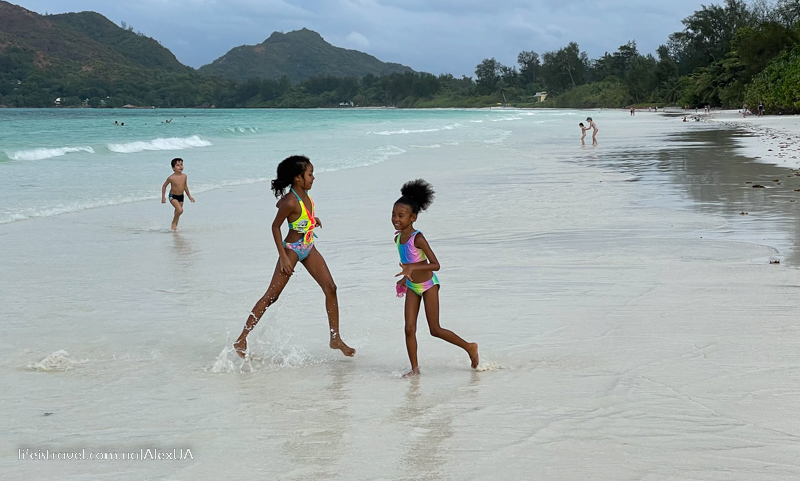
Seychelles follows a matrilineal system, which means Seychellois men engage in fishing and spend time with friends, while women hold responsible positions in banks, police, and large corporations. In other words, men enjoy more leisure time while women work and support their families.
On weekends, locals enjoy picnics on the beaches with large families. Some places may get crowded, but we never encountered any issues; Seychellois people are very friendly.
Roads and Driving
A car is essential in Seychelles. Staying in one place doesn’t make sense, and public transportation can be time-consuming and inconvenient. Some places are simply unreachable by bus.
Traffic drives on the left side of the road, following British tradition. The steering wheel is on the right side of the car, just in case anyone’s wondering. It’s the same as in Cyprus, Sri Lanka, and Thailand. There are no issues with this, even if you’re doing it for the first time.
On Praslin and Mahe, there’s an unfinished ring road around the island. It’s not completely sealed off, so you can’t go around it. The islands have hilly terrain, and the roads in the center can be quite winding.
A unique feature of Seychellois roads is the absence of shoulders in the center. The edge of the road drops off steeply, without any barriers. It may look scary at first, but if you drive carefully, there won’t be any problems.
These drop-offs are designed to divert water during heavy rains. Otherwise, the water would run across the roads. We learned this when we experienced a tropical downpour a few days before leaving.
The mentioned feature applies to Praslin and Mahe islands.
On La Digue, there are no cars, only special transportation and bicycles. A unique aspect of La Digue is that giant Seychelles tortoises may walk along the roads and beaches. It’s a fantastic sight.
Food and Dining
In Seychelles, there’s a popular dining format called TakeAway, which is similar to home-cooked meals. They prepare and sell food right on the spot, and the menu may vary depending on the catch brought in by local fishermen. The cuisine is predominantly Creole, featuring rice, meat, fish, and seafood, including local octopus and shrimp.
The prices for dishes range from $2 to $3, and the food is delicious. The main difference from restaurant dining is in the presentation and portion size. TakeAway portions are generous, and they often serve unlimited quantities of rice for just a small fee.
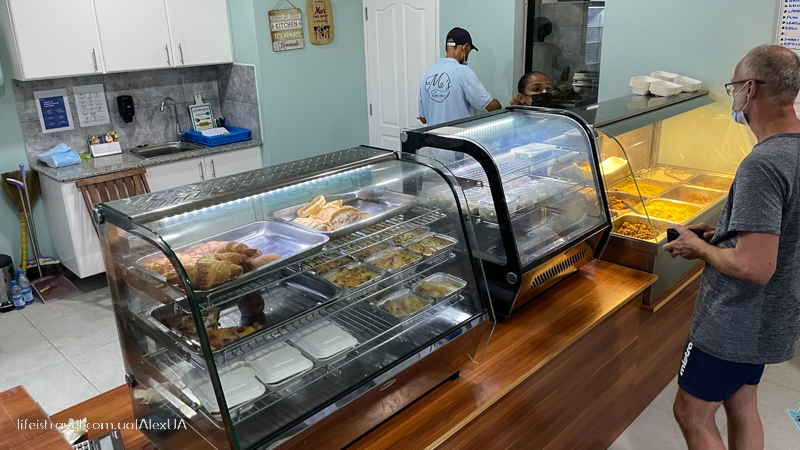
There are also tourist restaurants, but they tend to be expensive and not always as tasty. We tried some and found them to be hit or miss.
French restaurants are also present. Some require advance reservations and only serve lunch or dinner. For example, Del Place restaurant on Mahe is expensive but offers a lengthy dining experience, a beautiful view, and delicious food.

At popular beaches, you can find vendors selling and grilling fish right there on charcoal. It’s incredibly tasty and affordable, usually ranging from $10 to $20 for a meal for two. Prices may vary depending on the beach.
Stores and Supermarkets
This might come as a surprise, but Seychelles lacks the typical supermarkets we’re used to where you can buy groceries and cook your own meals. There are a few in the capital, Victoria, but making the trip to the capital can be inconvenient, even if it’s just a 30-minute drive.
About 90% of the shops are small stores, semi-dark shops along the road. They primarily sell beverages, and there’s hardly any food. Meat, poultry, and fish are usually frozen, and the selection is quite limited.
So, buying groceries and cooking for yourself is not a viable option in Seychelles. It’s easier to visit a nearby TakeAway, get some delicious pre-cooked food, and enjoy it on your balcony with a view. You may visit a supermarket once or twice during your entire vacation to buy something tasty or have a drink.
Alcohol, including beer and local rum, is sold from 11 AM. Small shops and supermarkets in the capital accept credit cards.
Can You Fly a Drone?
Yes, you can fly a drone in Seychelles, but there are restrictions. Pay attention to warning signs in the area and any guidance provided by your drone.
There are many restrictions near airports on Mahe and Praslin. Flying is not allowed in proximity to Victoria and around the airports. Most beautiful beaches, however, allow drone flights, and you usually don’t need special permits or see any prohibitive signs.
On La Digue, you can fly drones pretty much anywhere, even near the helipad. The only time they advise against flying is when local helicopters are about to land. There are warning signs.
Travel Insurance in Seychelles
While you may not be asked for travel insurance upon arrival, it’s more for your protection than the customs officer’s concern. They won’t provide free treatment for your fever, stomach issues, or injuries sustained while swimming.
We purchase travel insurance for ourselves through this provider. It’s very affordable and saves your budget and nerves. We’ve tried and tested it.
In Summary
Vacationing in Seychelles is reasonably priced.
Plan your route in advance, book accommodation, reserve a car, and purchase insurance.
Buy your plane ticket – the price range is provided above.
Purchase ferry tickets in advance to save time during your vacation.
Take your camera, smartphone, drone, and a few spare batteries. Bring credit cards and some cash, especially if you plan to visit remote areas. If you work remotely, bring your laptop. Don’t forget snorkeling gear.
Now, go ahead and enjoy your trip!